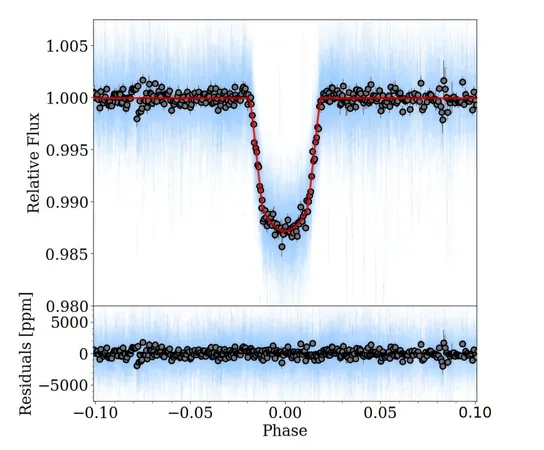
Astronomers Unveil Stunning Discovery of Young Super-Jupiter Exoplanet - What This Means for Future Research!
2024-11-21
Author: Olivia
In an exciting breakthrough, a team of international astronomers has successfully detected a newly identified super-Jupiter exoplanet, designated NGTS-33b, as part of the ambitious Next Generation Transit Survey (NGTS). This remarkable new addition to the exoplanet roster is located approximately 1,430 light years from Earth and boasts a mass nearly four times greater than that of Jupiter. What's more, this celestial giant is believed to be only millions of years old, making it one of the youngest known super-Jupiters.
The detailed findings were published on November 13 on the preprint server arXiv, highlighting the innovative techniques employed by the NGTS. This extensive survey primarily focuses on discovering Neptune-sized and smaller exoplanets that transit bright stars. Utilizing a network of small, fully automated telescopes situated at the Paranal Observatory in Chile, the NGTS operates within red-optical wavelengths, deploying the transit photometry method to observe and measure the tiny dimming of stars that occurs when planets move in front of them.
Leading the research team, astronomer Douglas R. Alves, and his colleagues have made this groundbreaking discovery around the massive and rapidly rotating star NGTS-33. "Here, we report the detection of NGTS-33b, the first NGTS discovery of a super-Jupiter hosted by a massive star," the researchers noted in their paper.
NGTS-33b measures an impressive 1.64 times the radius of Jupiter, with a calculated mass of around 3.63 Jupiter masses, resulting in a relatively low density of 0.19 g/cm³. The exoplanet completes its orbit every 2.82 days, situated very close to its host star—just 0.048 astronomical units away—with an estimated equilibrium temperature of a scorching 1,991 K.
Interestingly, the low density of NGTS-33b is 13% less than what would typically be expected for transiting hot Jupiters of similar mass. Furthermore, planetary structure models suggest that the planet's radius may be inflated by as much as 15%, hinting at unique formation or evolutionary pathways.
The host star, NGTS-33, is classified as a spectral type A9V, with a radius about 1.47 times that of the Sun and a mass that is roughly 60% greater than our star. With a rapid rotational period of 0.66 days and an effective temperature of 7,437 K, this star is quite energetic. Its age is estimated to fall between 10 and 50 million years, indicating a relatively youthful stellar lifespan.
What sets this discovery apart is its rarity; only 11 massive super-Jupiter exoplanets orbiting hot stars have been identified to date. The authors of the study emphasize the significance of their discovery, stating, "The finding of NGTS-33b will enrich the still-small but expanding population of massive transiting hot Jupiters and offer vital insights into existing theories about how such planetary systems form and evolve."
As researchers continue to explore the universe and uncover its mysteries, the discovery of NGTS-33b serves as a critical piece in the ever-growing puzzle of planetary science, paving the way for deeper understanding of these gigantic exoplanets and their formation. What other secrets lie beyond our solar system? Stay tuned for more exciting developments in the field of astronomy!









 Brasil (PT)
Brasil (PT)
 Canada (EN)
Canada (EN)
 Chile (ES)
Chile (ES)
 España (ES)
España (ES)
 France (FR)
France (FR)
 Hong Kong (EN)
Hong Kong (EN)
 Italia (IT)
Italia (IT)
 日本 (JA)
日本 (JA)
 Magyarország (HU)
Magyarország (HU)
 Norge (NO)
Norge (NO)
 Polska (PL)
Polska (PL)
 Schweiz (DE)
Schweiz (DE)
 Singapore (EN)
Singapore (EN)
 Sverige (SV)
Sverige (SV)
 Suomi (FI)
Suomi (FI)
 Türkiye (TR)
Türkiye (TR)